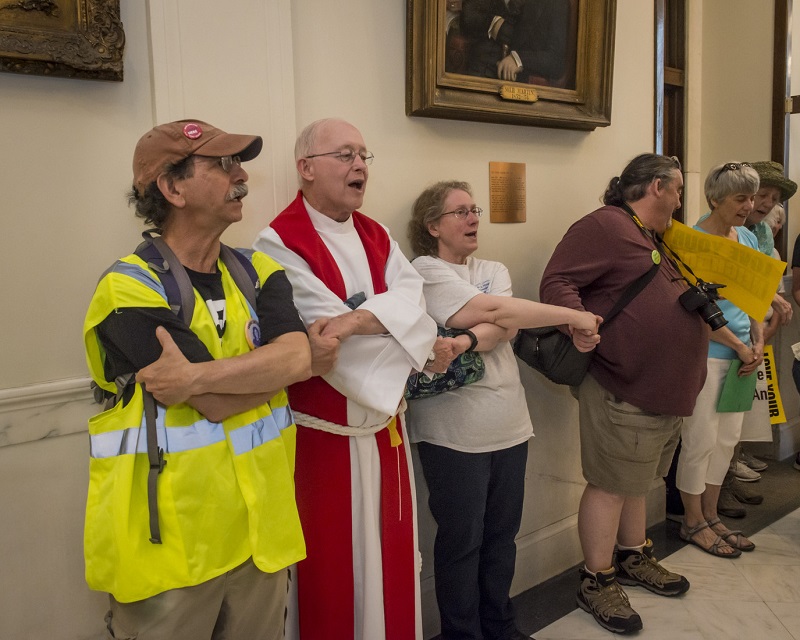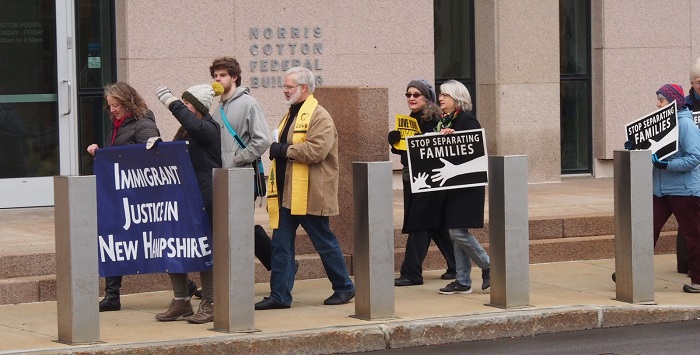
Arnie and protesters from the Poor People's Campaign Becky Field / Fieldwork Photos
Part 2 of an interview with Arnie Alpert, co-director of AFSC’s New Hampshire program
Since 1981, Arnie has coordinated AFSC's New Hampshire program. He’s a leader in movements for economic justice and affordable housing, civil and worker rights, peace and disarmament, abolition of the death penalty, and an end to racism and homophobia.
This is the second part in a two part interview. Read the first part here.
Sophia: What are the most critical actions that activists who are directly impacted by an issue and their allies should take?
Arnie: Well it’s important to start by understanding the analysis of the problem, which’s responsible for it, and what are the weaknesses in the system.
Gene Sharp is one of the great theorists here. He wasn’t an activist or an organizer; he was a scholar and spent pretty much his whole adult life studying nonviolent movements and nonviolent campaigns to try to figure out what people had done and what made them effective. Think about the words of the Declaration of Independence: it says that political authority derives from the consent of the governed. Gene Sharp basically said all authority derives from consent. And when that consent is withdrawn, that authority loses its ability to enforce its will. So if soldiers don’t fight, if police officers don’t arrest people, if workers don’t work, these things can stop a system from operating. If everybody in the Trump administration resigns, for whatever reason, he can’t get anything done.
What Sharp does, from his study of different movements, is divide the nonviolent techniques into three major groups: the first one being active protest and persuasion (marches, rallies, leaflets, street theater, writing blogs for AFSC, active protest and persuasion, and education).
The second area is what he calls noncooperation, so that would be for example, strikes or boycotts, a bit riskier than a protest because you are taking a larger stand and, likely, risk.
If you go back to the United Farm Workers union, they had marches, they had rallies, and they organized a nationwide boycott in which they said if people refused to buy lettuce or grapes that are grown by non-union companies, then that is going to put economic pressure on those big companies to recognize the union. And if people refuse to buy wine by the Gallo corporation, that’s going to put pressure on the Gallo corporation to recognize the right of workers in their grape field and their winery to have their rights as workers respected. Enough people over enough years did that, that the state of California in the end passed the first law that actually recognized the rights of farm workers to form unions.
If you go back to the National Labor Relations Act, which kind of normalized the ability of workers to form unions, it explicitly leaves out domestic workers and farm workers, most of whom were women and people of color. So California, passing an agricultural labor relations act that explicitly creates a process in which farm workers can form labor unions, becomes a victory as an outcome of a campaign that was influenced by strikes. A strike is basically a boycott of work, refusal to work, an act of noncooperation in the workplace. This organizing led to this victory. That victory makes it then possible for farm workers to more effectively organize for decent wages and safe working conditions in the fields.
The third big category that Sharp talks about is intervention, and that’s where you actually put yourself in the way of something that you’re trying to stop. So that’s when you’re talking about something like a blockade.
On campus, a walkout from class I would call an act of noncooperation, and then a speak-out we would call an act of protest. And then if you actually occupied the president’s office -- took over an administration building, something that many student protest groups have done at different times -- that would be an act of intervention. Part of what makes it a nonviolent action is that we’re doing it in a way in which we’re not trying to physically harm the people that we’re in conflict with and we also understand that we might be harmed ourselves. There has to be an implication of some willingness to accept suffering as an outcome, a willingness to accept suffering but not to inflict suffering.
You could get suspended from school, you could get a bad grade for missing class, you could get some other type of academic charges, get arrested, that all could come as an outcome of engaging in this action. If there’s no risk, it’s kind of hard to imagine what the impact is going to be. If it’s just a big march and then everybody goes away, it’s pretty easy for any system of power to live with that, even smile at it and say, “Aren’t they cute?”
Sophia: How are you working to move white people into the racial justice movement and the movement for social change? What’s working and what’s not working?
Arnie: New Hampshire is a mostly white state. So the challenge there is not how to get white people involved but how to get the white people that are involved acting in ways that are grounded in anti-racism, grounded in solidarity and not expressions of what we call a white savior complex. We’ve been doing regular prayer vigils at the federal building in Manchester, New Hampshire, which is where the Immigration and Customs Enforcement (ICE) office is, and where people who are under orders of deportation and orders of supervision from ICE have to show up on a regular basis to do what we call check-in appointments.
Every time we do this action we’re aware of people who have check-in appointments with ICE, we show up outside the building. We have a prayer vigil and we do what we call the Jericho walk, where we walk seven times around the block where the ICE central building is, and then conclude with more prayers and songs. Most of the people who participate in this are people who would be classified as white, very few of them are immigrants, and we try to do it in ways that open spaces for people who are directly threatened by ICE to participate if they want to or to feel that they are supported by this process.

It’s interesting because of the way it works, sometimes it feels a little odd, but over time the fact that we’ve been coming back week after week and month after month, it’s clear that the people who have to go into that building understand who we are and why we’re there and feel a sense of moral support from the vigils.
One of the interesting things that King said in “Stride for Freedom”, the story of the Montgomery bus boycott campaign, was that nonviolent direct action does not start out by working on your adversary; it starts out by working on the people who use it. The people who use nonviolent direct action get strength from it and that enables them to carry on and do more work around social change. Perhaps take bigger risks or just persist.
A couple weeks ago, we had a couple people who know how to blow the shofar (a ram’s horn trumpet). Three weeks ago we’re at the vigil and a couple of clergy people were inside the lobby to provide counsel to immigrants who wanted to talk to them. They could overhear a discussion in the hallway with one of the security guards in the building from the federal protection service who’s talking to someone who’s going into the building who says, “What is that noise what’s going on back there?”
The security guard says, “Oh they’re blowing on the shofar. This is related to the seventh chapter of the book of Joshua in the Old Testament where the Israelites marched around the building and prayed for the walls to come tumbling down and that’s what they’re doing.” So we had the security guard explaining to somebody what we were doing and why we were there. He got it, and was able to describe it to someone.
That wasn’t our objective, trying to convert the federal protective service to be on our side, but in part because of the way we’re doing it, because of the clarity of our message and the integrity of our witness, he’s able to understand it and not feel that we’re demonstrating against him. He knows we’re demonstrating against the immigration system, and maybe even the people that support ICE, understand that we don’t yell and scream at them, we’re interested in how to communicate with them.
Sophia: In this political moment, what gives you hope?
Arnie: What gives me hope is that there are so many people who are saying “no.” It’s really important to be the resistance and to be the people that say no to misogyny and no to racism and no to violence, no to this exploitive ultra-capitalism. At the same time we have to be the people that say “yes.” Yes to equality, yes to peace, yes to social justice, yes to living in harmony with the earth, and I think that’s also where the Quakers really have a way to approach this that’s helpful for the moment that we’re in. That it’s that our lives speak and not just our words, that it’s being out in the world with integrity and trying to live according to our values. Ultimately that has profound transformative power, changing the people and institutions around us.